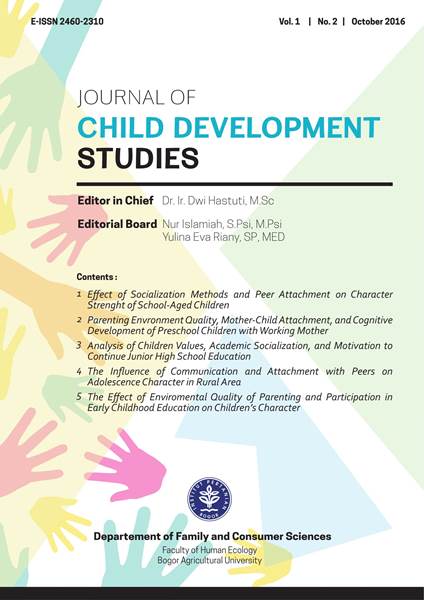The Influence of Communication and Attachment with Peers on Adolescence Character in Rural Area
Abstract
Adolescence is a unique phase because at this stage the person becomes more
independent, and togetherness intensity with peers increases at this stage. However, adolescent relationships with peers can affect positively or negatively on adolescent characters. This study aimed to analyze the effect of adolescent-peers communication and attachment on adolescent characters. The study was conducted in Pamijahan, Bogor Regency, involving 109 students of Vocational High School (SMK). Data were collected by using a modified instrument of the
Parent-Adolescent Communication Scale, Adolescent Attachment Questionnaire and VIA-Youth. Data were processed by using descriptive analysis and regression analysis. The results indicated high communication problem between adolescents and their peers. In addition, that was low openness among adolescents and their peers. The attachment between adolescents and
their peers were also found low. The scores of rural adolescents character in this study were relatively low. It was allegedly associated with a low score of communication and attachment with peers. Results of regression analysis showed that only the attachment with peers has a significant effect on the scores of adolescent characters in rural.
Downloads
References
Barnes HL, Olson DH. 1982. Parent-adolescent communication scale. St. Paul: Family Social Science, University of Minnesota
Berndt TJ. 1982. The features and effect of friendship in early adolescence. Child Development 53
Berndt TJ. 2002. Friendship quality and social development. Current Directions in Psychological Science 11(1)
[BPS] Central Bureau of Statistics. 2013. Data and information poverty Regency / City in 2013 [Internet]. [Downloaded 2015 Sept 01]. Available at: www.bps.go.id.
Bronfenbrenner U, Morris PA. 2006. The Bioecological Model of Human Development. US: John Wiley & Sons Inc.Bronfenbrenner U,
Morris PA. 2006. The Bioecological Model of Human Development. US: John Wiley & Sons Inc.
Chassin L, Presson CC, Sherman SJ, Montello D, McGrew J. 1986. Changes in peer and parents influence during adolescence: Longitudinal versus cross-sectional perspectives on smoking initiation. Developmental Psychology 22 (3)
Data center and the Ministry of Health information. 2014. Say no to drugs: Say yes to life [Internet]. [Downloaded in 2015 Mar 25]. Available at: http://www.depkes.go.id/resources/download/pusdatin/infodatin/infodatin-antinarkoba.pdf.
Dewanggi M. 2014. Influence of attachment, parenting style, and environmental quality child care to rural and urban character [thesis]. Bogor: Study Program of Family and Child Development, Bogor Agricultural University
Dodge K, Gonzales N. 2009. Family and peer influences on adolescent behavior and risk-taking. Paper presented at IOM Committee on the Science of Adolescence Workshop, Washington, DC.
Fass ME, Tubman JG. 2002. The influence of parental and peer attachment on college students’ academic achievement. Psychology in the Schools 39(5). Doi: 10.1002/pits.10050
Freeman H, Brown BB. 2001. Primary attachment to parents and peers during adolescence: Differences by attachment style. Journal of Youth and Adolecence 30(6)Fuligni AJ, Eccles JS. 1993. Perceived parent-child relationship and early adolescents’ orientation toward peers. Developmental Psychology 29(4)
Hair EC, Jager J, Garrett SB. 2002. Helping teens develop healthy social skills and relationships: What the research shows about navigating adolescence. Child Trends Research Brief
Karina, Hastuti D, Alfiasari. 2013. The behavior of bullying and teenage characters and their relationship with the family and peer group characteristics. Journal of Family and Consumer Sciences 6 (1).
Lerner RM, Steinberg L. 2004. Handbook of Adolescent Psychology. New Jersey: John Wiley & Sons, Inc.
Lickona T. 1994. Raising Good Children. Amerika (US) : Bantam Books.
Meeus W, Oosterwegel A, Vollebergh W. 2002. Parental and peer attachment and identity development in adolescence. Journal of Adolescence Peterson C, Seligman MEP. 2004. Character Strengths and Virtues: A Handbook and Classification. New York: Oxford Univrsity Press
Rosenthal NL, Kobak R. 2010. Assesing adolescents’ attachment hierarchies: Differences across developmental periods and associations with individual adaptation. Journal of Research on Adolescence
Santrock JW.1996. Adolescence. New York: McGraw-Hill
Santrock JW. 2007. Life-span Development. New York: McGraw-Hill
Selby JC. 2000. The relationship of parental attachment, peer attachment, and selfconcept to the adjustment of first-year college students [Disertasi]. Texas: University of North Texas
Soetjiningsih CH. 2007. The parent-teenager relationships and self-esteem as a predictor of peer pressure on adolescents [thesis]. Christian University Satya Discourse. Yogyakarta
Waters E, Hamilton CE, Weinfield NS. 2000. The stability of attachment security from infancy to adolescence and early adulthood: General introduction. Child Development 71(3)
West M, Rose SM, Spreng S, Sheldon-Keller A, Adam K. 1998. Adolescent attachment questionnaire: A brief assessment of attachment in adolescence. Journal of Youth and Adolescence 27(5)
Zimmermann P. 2004. Attachment representations and characteristics of friendship relations during adolescence. Journal Experimental Child Psychology 88

